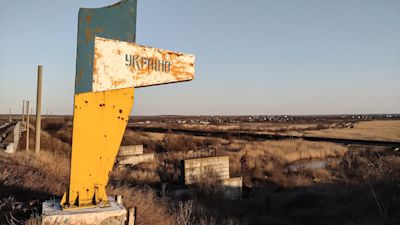Insight
Transnistria: The next target for Vladimir Putin and Russia?

There is real and concerning potential for the war in Ukraine to spill over and for violence to reach neighbouring countries.
The most volatile, and immediately vulnerable, is Moldova, in particular its Russian-speaking breakaway region of Transnistria.
Pro-Russian militant separatists unilaterally detached themselves from Moldova in 1992 to create Transnistria. It is now wedged between Moldova and Ukraine, but its independence has never been internationally recognised. It remains run by a highly secretive regime that restricts media freedoms and is in constant tension with the Moldovan government.
In the past week, the mysterious enclave was suddenly rocked by a series of explosions.
The administration’s security headquarters - home to Transnistria’s own version of Russia’s FSB - was attacked in the capital city of Tiraspol. A group were captured on CCTV using two handheld launchers which were then discarded and left behind at the scene. Nobody was killed.
In another incident near the village of Maiac, two radio transmission towers were damaged in explosions. The towers were sending out Russian language broadcasts across the region. Again there were no casualties.
A number of similar incidents followed, and the Transnistrian authorities responded by raising a ‘red alert’ for threat level.
Police have been deployed to patrol the streets inspecting vehicles and documents, and the border going into Transnistria is closed until 10 May.
Authorities expect further attacks and have started testing a text message system to warn citizens of new security alerts.
The question is: who is responsible for the sudden attacks? No one has yet claimed responsibility.
Pro-Russian separatists in Transnistria blame Ukraine. The Moldovan government suggests it was internal groups within Transnistria carrying out provocations.
Watchers of the Putin playbook will also feel they’ve seen this before.
Coming to the defence of Russian speakers facing oppression was the pretext for intervention in Ukraine, and in Georgia before. It’s been part of the pressure from the Kremlin on former Soviet countries like Estonia, Lithuania, and Latvia.
So, whoever carried out the attacks, it will likely be noted in Moscow that the targets picked in Transnistria were ostensibly part of the Russian identity for people there.
Russia has also openly declared its intent to reach Transnistria in the next phase of its Ukraine invasion.
Could this have been Russia carrying out a ‘false flag’ to justify getting more involved in Transnistria and mobilise the local population? It’s possible.
These developments have spread fear in Moldova and Europe that Putin’s expansion plans don’t stop at Ukraine’s border.
Moldova is a former Soviet state and Putin is transparent in his appetite to recapture those countries that were once part of the USSR. Moldova is not a member of NATO or the EU, so there is unlikely to be much if any resistance should the Kremlin decide to send forces in.
However, separating the reality from the rhetoric provides important context to what’s truly going on behind Transnistria’s veil of secrecy.
Firstly, Putin already has a presence in Transnistria.
There are around 1,300 “Russian peacekeepers” currently stationed there.
What you need to know - Listen to the latest episode
These are, officially, part of Russia’s military but few of the troops have ever actually set foot on Russian soil. They are mostly men born in Transnistria, entitled to a Russian passport and a Russian uniform. How committed they are to defend a ‘Mother Russia’ they’ve never really known is another question.
There has been no clamour from ordinary people in Transnistria to get involved in the Ukraine war. In fact, the lack of public support for Putin’s invasion has been conspicuous by its absence.
What is revealing is video taken at the Transnistria border going into Moldova immediately after the first attacks shows queues of cars fleeing en masse. ITV News has verified the video is real.
At the first sign of involvement in the war next door, Transnistrians weren’t rushing to take up arms and join forces with Putin; they were trying to escape.
Transnistria is not short of weapons for people to fight with. It happens to be home to one of Europe’s biggest munition depots, based in Cobasna, which was notably another of the areas targeted in attacks over the past week.
This depot is believed to store around 20,000 tonnes of weapons, including tanks. However, as we’ve seen with Russia’s invasion of Ukraine, weapons like this are rendered useless if not maintained and there’s little knowledge of how well that’s been done over the past 30 years since the civil war.
Additionally, Transnistria is riddled with corruption and more than one analyst familiar with the region has raised with me the possibility that some of the armoury in storage could already have been ‘unofficially’ sold off.
In spite of all this, there is a very valid, strategic reason for why Russia would go out of its way to link with Transnistria.
It presents Putin with the opportunity to create a Russian-controlled corridor spanning the length of Ukraine’s Black Sea coast.
Ultimately, linking the port-city of Odesa with Transnistria would also leave the surviving parts of Ukraine completely landlocked, financially weakened, and utterly diminished.
That would be a hugely significant victory for the Russian premier to take back to his people. Ukraine would be humiliated.
However, getting to Transnistria means taking Odesa first and, as we’ve seen in another Ukrainian port-city of Mariupol, these objectives are easier said than done. Resistance in Odesa would be even tougher given the scale of defensive preparations and readiness.
Taking Transnistria is a Russian ambition - there’s no doubt about that anymore. But the idea Putin’s troops are about to stroll through Odesa to join forces with an appreciative crowd in Transnistria is a better reflection of the disconnect between what the Kremlin believes and the reality on the ground of what their forces are capable of. For now, at least.